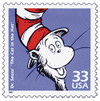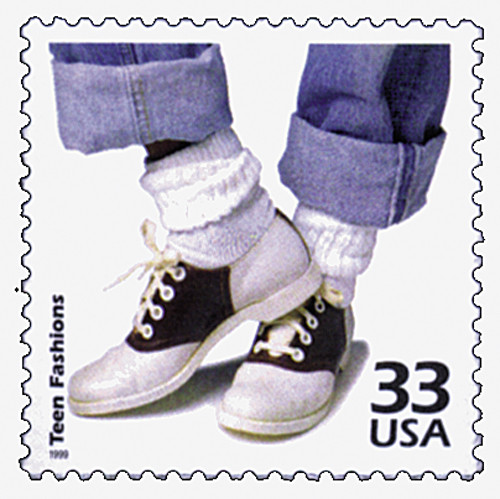
# 3187h - 1999 33c Celebrate the Century - 1950s: Dr. Suess' Cat in the Hat
US #3187h
1999 Dr. Seuss’ “The Cat in the Hat” – Celebrate the Century (1950s)
• Part of the sixth sheet in the Celebrate the Century stamp series issued from 1998-2000
• Commemorates Dr. Seuss and his famous “The Cat in the Hat”
• Includes text on the back with historical details
Stamp Category: Commemorative
Series: Celebrate the Century
Value: 32¢ First Class Mail Rate
First Day of Issue: May 26, 1999
First Day City: Springfield, Massachusetts
Quantity Issued: 188,000,000
Printed by: Ashton Potter (USA) Ltd.
Printing Method: Offset, Intaglio
Format: Panes of 15
Perforations: 11.5
Tagging: Block Tagging
Why the stamp was issued: To honor the literary contributions of Dr. Seuss and his beloved story “The Cat in the Hat.”
About the stamp design: Pictures a reproduction of a Dr. Seuss drawing from “The Cat in the Hat.” Includes the following text on the back: “’The Cat in the Hat’ (1957) was written and illustrated by Dr. Seuss (Theodor Seuss Geisel). This masterpiece uses repeated syllables, rhythmic verse, and fanciful drawings to teach children to read and to use their imaginations.”
First Day City: The First Day of Issue Ceremony was held at the Civic Center in Springfield, Massachusetts, the hometown of Dr. Seuss.
About the Celebrate the Century series: The USPS launched the Celebrate the Century series in 1998 to mark the end of the 20th century and herald the arrival of the 21st. The series includes 10 sheets of 15 stamps (150 in total), with each honoring important moments from a different decade (1900s, 10s, 20s, 30s, 40s, 50s, 60s, 70s, 80s, and 90s). At the time of completion, it was the longest and most ambitious commemorative stamp series in US history.
History the stamp represents: In the 1950s, illiteracy among children in the US was on the rise. Experts blamed America’s interest in television, coupled with the belief that most children’s books were dull and unappealing. In 1955, Theodor Seuss Geisel, better known as Dr. Seuss, began writing a children’s book from a vocabulary list of 225 words. After much frustration, he decided that the first two words from the list that rhymed would be the title of the book. That is how “The Cat in the Hat” was born.
As Dr. Seuss struggled with the verse, he made sketches of the Cat. He wanted a sly troublemaker who wouldn’t strike readers as mean. The tall, wily character in a red-and-white stovetop hat confidently walked on two legs and could juggle and ski. Dr. Seuss combined fanciful illustrations with simple, clever verse to describe the character’s fantastic personality. The Cat became the best-known animal in the Dr. Seuss menagerie.
“The Cat in the Hat” sold out in bookstores across the country as soon as it was released in 1957. It became a national sensation, with nearly a million copies sold within three years. Editions were available in French, Chinese, Swedish, and Braille. As a result of the success of “The Cat in the Hat,” Dr. Seuss started Beginner Books, a publishing house for children’s stories.
US #3187h
1999 Dr. Seuss’ “The Cat in the Hat” – Celebrate the Century (1950s)
• Part of the sixth sheet in the Celebrate the Century stamp series issued from 1998-2000
• Commemorates Dr. Seuss and his famous “The Cat in the Hat”
• Includes text on the back with historical details
Stamp Category: Commemorative
Series: Celebrate the Century
Value: 32¢ First Class Mail Rate
First Day of Issue: May 26, 1999
First Day City: Springfield, Massachusetts
Quantity Issued: 188,000,000
Printed by: Ashton Potter (USA) Ltd.
Printing Method: Offset, Intaglio
Format: Panes of 15
Perforations: 11.5
Tagging: Block Tagging
Why the stamp was issued: To honor the literary contributions of Dr. Seuss and his beloved story “The Cat in the Hat.”
About the stamp design: Pictures a reproduction of a Dr. Seuss drawing from “The Cat in the Hat.” Includes the following text on the back: “’The Cat in the Hat’ (1957) was written and illustrated by Dr. Seuss (Theodor Seuss Geisel). This masterpiece uses repeated syllables, rhythmic verse, and fanciful drawings to teach children to read and to use their imaginations.”
First Day City: The First Day of Issue Ceremony was held at the Civic Center in Springfield, Massachusetts, the hometown of Dr. Seuss.
About the Celebrate the Century series: The USPS launched the Celebrate the Century series in 1998 to mark the end of the 20th century and herald the arrival of the 21st. The series includes 10 sheets of 15 stamps (150 in total), with each honoring important moments from a different decade (1900s, 10s, 20s, 30s, 40s, 50s, 60s, 70s, 80s, and 90s). At the time of completion, it was the longest and most ambitious commemorative stamp series in US history.
History the stamp represents: In the 1950s, illiteracy among children in the US was on the rise. Experts blamed America’s interest in television, coupled with the belief that most children’s books were dull and unappealing. In 1955, Theodor Seuss Geisel, better known as Dr. Seuss, began writing a children’s book from a vocabulary list of 225 words. After much frustration, he decided that the first two words from the list that rhymed would be the title of the book. That is how “The Cat in the Hat” was born.
As Dr. Seuss struggled with the verse, he made sketches of the Cat. He wanted a sly troublemaker who wouldn’t strike readers as mean. The tall, wily character in a red-and-white stovetop hat confidently walked on two legs and could juggle and ski. Dr. Seuss combined fanciful illustrations with simple, clever verse to describe the character’s fantastic personality. The Cat became the best-known animal in the Dr. Seuss menagerie.
“The Cat in the Hat” sold out in bookstores across the country as soon as it was released in 1957. It became a national sensation, with nearly a million copies sold within three years. Editions were available in French, Chinese, Swedish, and Braille. As a result of the success of “The Cat in the Hat,” Dr. Seuss started Beginner Books, a publishing house for children’s stories.














